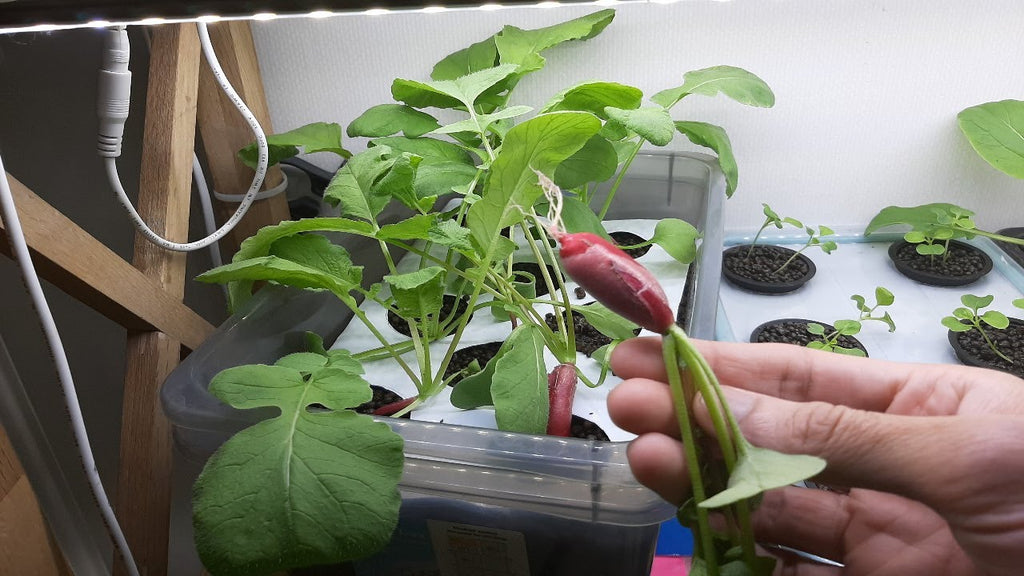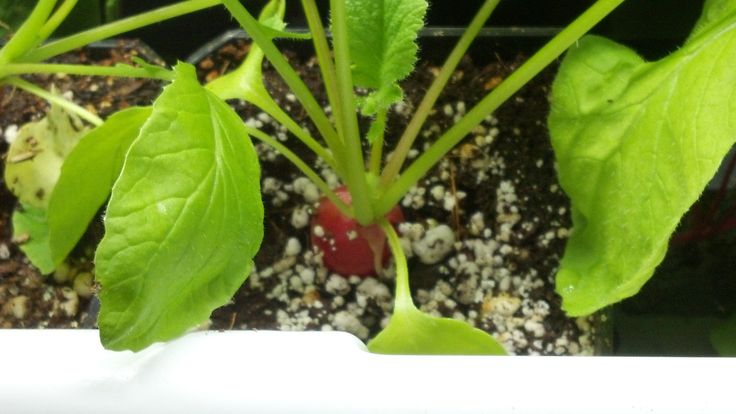How To Grow Hydroponic Radish
Hydroponics is the art of growing plants without soil. It's a fast-growing field of agricultural technology that allows us to farm in limited space. We can create controlled settings for the plants.
When you grow radishes, hydroponics can save you time and resources and help you get a lot of radishes.
This guide will show you step-by-step instructions on how to grow radishes hydroponically. It will help you have a successful and rewarding gardening experience.
Can You Grow Radishes Hydroponically?
Absolutely! Radishes are an excellent choice for hydroponic gardening. They grow fast and reach maturity in 3 to 4 weeks. They are great for a fast and bountiful harvest.
Taking care of radishes is easy as long as you provide enough nutrients and light. If you set it up and take care of it, hydroponic radishes can grow well and give a bigger harvest than soil-grown ones.
How To Grow Hydroponic Radish - Step By Step Guide

If you want to grow hydroponic radishes, our expert tips and guide will help you. Follow these guidelines to grow tasty hydroponic radishes that are healthy and nutritious.
Now, let's get right into the exciting world of hydroponic gardening. We'll learn how to grow hydroponic radishes like experts!
Read More: Top Tips for Outdoor Hydroponics Yields
Start By Choosing The Best System For Growing Radishes Hydroponically
When growing plants hydroponically, there are many systems to choose from. Deep Water Culture (DWC) and Nutrient Film Technique (NFT) are the top systems for growing radishes.
The DWC system suspends the plants in nutrient-infused water. The roots are submerged directly in the solution. The system is very efficient. It gives water, oxygen, and nutrients to the roots, helping them grow faster.
However, the NFT system uses a thin film of nutrient solution that flows over the plant roots. The plants are positioned on a gentle slope. The system supplies essential nutrients, water, and oxygen while keeping the plant's upper part dry. This reduces disease risk.
You can choose either system based on your needs and resources. Both have advantages. Either way, these systems will provide your radishes with a suitable environment to grow and thrive.
Read More: How Does Hydroponics Work?
How Do You Start Hydroponic Radishes?
-
Seedling Tray: To start, fill a seedling tray with rockwool cubes. These cubes are great for radish seeds because they hold water well and allow for airflow.
-
Sowing Seeds: Once the tray is prepared, sow two to three radish seeds per rockwool cube. Gently press the seeds into the cube, making sure they're not too deep.
-
Germination: Place the tray in a warm, dark area and maintain a consistent temperature of around 20-22°C (68-72°F). Usually, radish seeds will germinate within three to seven days.
-
Transplantation: Once the seedlings have grown a few real leaves, it's time to move them to your hydroponic system. Make sure to handle the delicate roots with care during this process.
How Much Light Do Hydroponic Radishes Need?

Hydroponic radishes require a significant amount of light to flourish. Ideally, they should be in light for six hours per day, but it's better to have eight to ten hours. Make sure your plants get plenty of direct sun if you're using natural light.
But if you want more consistent lighting, you can use a grow light instead. To help plants grow better, use a timer for grow lights. This will mimic day and night. Soft light fluorescents are particularly effective, providing ample light energy at lower intensities. Your hydroponic radishes will grow best when you have good lighting for them.
For optimal results, keep the daytime temperature between 72 and 76 degrees Fahrenheit. At night, it can drop to around 60 degrees Fahrenheit.
Read More: Hydroponic Systems: How To Clean and Reuse Water
Tips For Growing Radishes Hydroponically Indoors
Growing radishes indoors using hydroponics saves space and allows for year-round cultivation. Here are some tips to ensure a successful indoor hydroponic garden:
-
Maintain a Consistent Environment: Indoor hydroponic systems allow for greater control over environmental factors. Ensure consistent light exposure, temperature, and humidity levels to promote healthy growth.
-
Monitor Nutrient Solution: Regularly check the pH and nutrient levels in your hydroponic system. Radishes thrive in a solution with a pH level of 6.0-7.0. Too high or too low a pH can lead to nutrient lockout, hindering plant growth.
-
Prune Regularly: Prune your radishes regularly to maintain their shape and size. This also stimulates growth and ensures the plants receive ample light.
-
Pest and Disease Management: Monitor your crops for signs of pests or diseases. Use natural pest control methods and clean your system regularly to mitigate these risks.
-
Harvesting: Radishes are ready to harvest when they are about one inch in diameter at the soil line. Gently pull the radish from the hydroponic medium, being careful not to damage the plant or roots.
Remember, the key to a successful hydroponic garden lies in careful care and monitoring of your plants. With these tips in mind, you're well on your way to a fruitful indoor harvest.
What Are The Benefits Of Growing Radishes Hydroponically?

-
Sustainable and Eco-Friendly: Hydroponic gardening practices are sustainable and eco-friendly, as they use significantly less water and space compared to conventional farming methods.
-
Controlled Environment: With hydroponics, you have total control over the growing environment. This allows for optimal growth conditions and eradicates the need for pesticides or herbicides, leading to healthier and more organic produce.
-
Increased Yield: Hydroponically grown radishes have the potential to yield larger and more plentiful harvests. The controlled environment and constant availability of nutrients often result in plants growing faster and producing more.
-
Year-Round Cultivation: Hydroponic gardening enables you to grow radish all year round, irrespective of the outdoor weather conditions.
-
No Soil-Borne Diseases: As hydroponics does not use soil, the risk of soil-borne diseases and pests is completely eliminated.
-
Easy Harvesting: Hydroponic radishes are easier to harvest as they grow in easily accessible trays or containers and don't have soil clinging onto them.
Read More: How To Grow Hydroponic Plants
Common Challenges and Solutions in Hydroponic Radish Cultivation

Despite the numerous advantages of hydroponic gardening, it's not without its challenges. However, if you understand these issues and know how to fix them, you'll be more successful. When growing radishes hydroponically, you may come across common problems. Here are solutions to these problems.
-
Nutrient Deficiencies: The most common symptom of nutrient deficiencies is yellowing leaves. This can be resolved by adjusting the nutrient solution or experimenting with different hydroponic nutrients.
-
Overcrowding: Overcrowding can lead to stunted growth and increased risk of disease. Ensure adequate spacing between plants to promote healthy growth and air circulation.
-
Root Rot: This is caused by waterlogged conditions or a lack of oxygen in the water. To combat this, ensure your hydroponic system provides ample aeration and avoids overwatering.
-
Temperature Fluctuations: Radishes prefer cooler temperatures. If your system gets too warm, it could hinder growth. Monitor and regulate your system's temperature for optimal plant health.
-
Pests and Diseases: Even though hydroponic systems eliminate soil-borne pests and diseases, they can still be susceptible to other types. Regular inspection and prompt action can keep your plants healthy.
Remember, troubleshooting is an integral part of gardening. With experience, patience, and careful observation, you can successfully grow healthy and delicious radishes hydroponically.
Frequently Asked Questions
Can radishes grow in just water?
Radishes indeed can grow in just water, a method known as hydroculture. However, for optimal growth and development, it's best to use a nutrient solution instead of plain water. The nutrient solution provides essential minerals and nutrients that radishes need to thrive.
What is the best hydroponic system for radishes?
The best hydroponic system for radishes is typically a deep water culture (DWC) system. This system allows the radishes to access water, nutrients, and oxygen directly, promoting a faster growth rate. It's easy to set up and maintain, making it ideal for beginners.
What pH should hydroponic radishes be?
Hydroponic radishes should ideally be grown in a nutrient solution with a pH level between 6.0 and 7.0. This range allows for optimal nutrient absorption, ensuring healthy and robust growth. Adjustments can be made using pH up or down solutions as needed to maintain the correct balance.
What makes radishes grow faster?
Radishes grow faster with good conditions: enough nutrients, consistent light, and ideal temperature. Regular monitoring and adjustments to maintain the health of the plant can significantly boost its growth rate. Pruning and maintaining the correct pH level also contribute to faster growth.
Read More: Top 8 Mistakes Made by Hydroponic Growers
Final Thoughts On How To Grow Hydroponic Radish
Growing hydroponic radishes is a rewarding way to garden that's efficient and sustainable. Although it may seem complicated, with careful planning and maintenance, it becomes easier.
To succeed in hydroponics, create a good environment with light, nutrients, and care. This innovative method is worth exploring because it allows year-round cultivation and higher yields. It is also eco-friendly.
Growing hydroponic radishes is a rewarding gardening experience, whether you're experienced or new. So why not take the leap and start your journey into the world of hydroponic gardening today?
Last Updated: 8 December 2023








